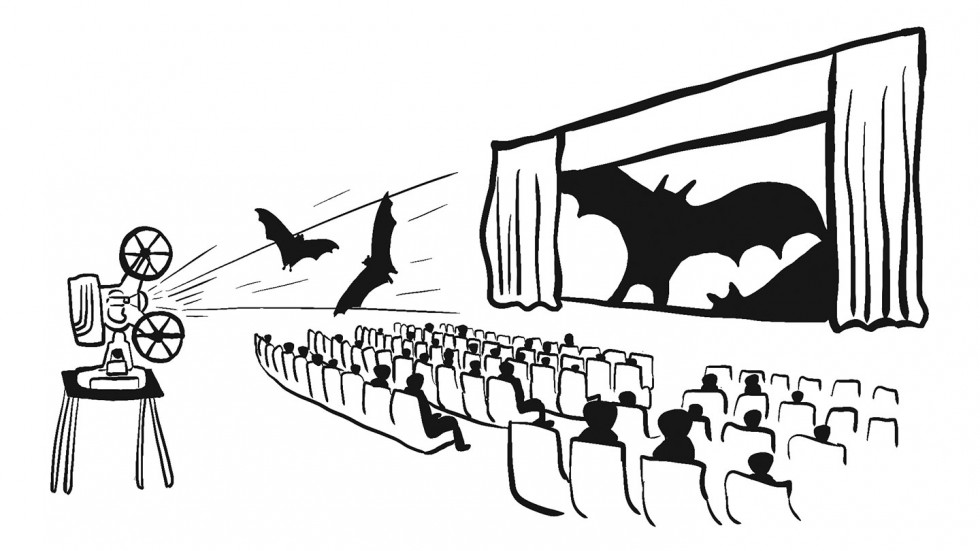How Death Keeps History Alive
“There’s very little artifice to the American story when you look at how we treat the dead,” according to…
Read The Story
Robert J. Clawson '59, Acton, Massachusetts, shares a memory about how Antoni H. Milkowski ’57, who died in 2001, ultimately became a beloved art professor at Hunter College.
“In late autumn of 1956, Tony Milkowski and I were laughing about the frequency of bats whizzing through the beam of the projector on movie nights in Rosse Hall. They distracted from most films, but would be perfect, we mused, for horror flicks that were, unfortunately, missing from the movie menu. “Notorious,” yes; “Nosferatu,” no. When we learned that “Dr. Sin’s Midnight Horror Show” was coming to the Vernon (theater), we decided to enhance the event with, yes, bats.
“We planned to enter the theater from the rear and let any guard know that we had brought the bats for “Dr. Sin.” Tony and I were both older than most students. I was tall and bearded, and Tony’s rubber face could change from the austerity of a Polish prince to that of a zany comparable to Marty Feldman. Our dark costumes, including black capes and hats, meant our theatrical authenticity would allow easy passage in time to open a suitcase filled with bats and make a quick, professional exit. All we really needed was a dozen live bats.
“Earlier in the year, I’d discovered that if I opened a casement in the lamp-lit Psi U lounge, a bat or two would occasionally enter. We had a purloined No U Turn sign, and if I held it at arm’s length, a bat would fly right up to it and make an abrupt U turn. I figured we could capture it with a net. We might gather a good number over, say, three nights. The first night, none showed. The second, nada. The third night, same thing. So we canned that effort and headed to Rosse Hall, sure we could find several. After checking behind every curtain and exploring every nook and cranny of the building, we came up empty. Fabrics? Drapes? Tapestries? Baffles? The Hill Theater!
“We snuck in. Tony and I were checking behind wall baffling and the many stage curtains. Rob Roleson '59, who’d joined this escapade, was creeping along a beam above the stage, poking his broom handle into the high reaches, when Jim Michaels roared, ‘What the hell are you doing in my theater?’ Had anyone ever seen him angry? ‘We’re not insured for daredevils, Roleson. Get your ass down here immediately.’ We were instantly meek, slinking toward the front exit, heads bowed, but there was no way to skirt the enraged professor. “‘Bats? Bats? That’s pretty easy, I’ve just found three of them! Get out of here, and don’t show your faces until next semester.’ And then he smiled, ‘Unless you’d like to sweep up after a show.’
“We’d pretty much exhausted the possibilities on campus, so Tony and I decided to take to the countryside in search of farmers who’d let us check out their barns. Tony prepped a polite introduction — explaining his status as a biology major, his hope to be accepted by a medical school impressed by his lab experiments with bats. His pitch worked, and most of the farmers were fine with it, though they all noted they’d not seen any bats for a while. On our third day not finding any, one farmer asked us if we’d checked out the caves down in Howard. We’d never heard of them, but he said he thought they were right near the center of town. That sounded surefire, so the next day we headed for Howard. A friendly local woman gave us directions to what turned out to be an enormous rock pile that concealed cracks and fissures too tight for Tony to crawl through.
“We were pretty much at a dead end when, on our trip back from Howard, we passed a beautifully kept farm with a huge barn near a stretch of the Kokosing that looked like a clear trout stream with a lovely sand and pebble beach, great for fly- and mosquito- devouring bats. We backed up, pulled into the drive, and Tony made his last, and most confident pitch to the owner, who looked more like a gentleman farmer than the real thing. He had a wry twinkle in his eyes.
“‘I’d be happy to let you explore my barn, but first I’d like to show you my operation and animals.’ We, of course, were delighted as he led us through stalls and containments for cows, pigs and sheep. I’d grown up in rural towns and had never seen such a well-kept ‘operation’ or healthy-looking domestic animals. He led us to his immaculate hay barn, and we checked it out. No bats.
“‘I majored in biology, too,’ he nodded to Tony. ‘Princeton. Don’t know what they teach you up at Kenyon, but we learned that some bat species hibernate, some migrate and some do both, depending on weather and locale. You might find a few hanging out in winter, but around these parts, just about all of them migrate.’ He paused for about five seconds, then, ‘Might want to change your major.’
“Tony took up sculpture. His installations adorn many parks and public spaces, where everyone can marvel at them … including bats.”
“There’s very little artifice to the American story when you look at how we treat the dead,” according to…
Read The StoryHow Writer-in-Residence P.F. Kluge ’64 and his wife, Pamela Hollie, became surrogate parents to a generation…
Read The Story20 things to know about Kenyon’s twentieth president that you won't find on her resume.
Read The Story